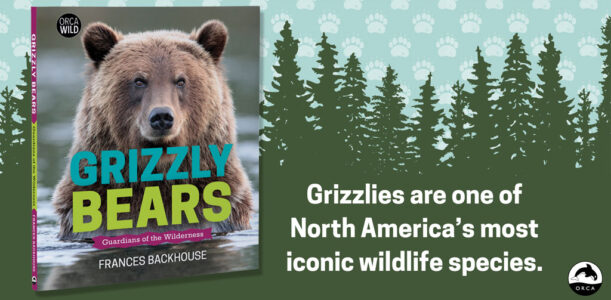Grizzles once roamed across half the continent, but today the grizzly population has declined at an alarming rate and it is incredibly difficult to rebuild those numbers, especially in places with a lot of people. Yet grizzlies are key members of their ecological communities and a powerful symbol of wilderness. Filled with facts and richly illustrated with photos, Grizzly Bears: Guardians of the Wilderness explores the biology of grizzlies and the vital ecological role these bears play, and it asks readers to consider what it takes to share the land with them. Learn from conservationists, scientists, Indigenous Peoples and young people who are working to ensure that grizzlies will be with us forever.
In this Q&A, author Frances Backhouse shares the inspiration behind her new book, some surprising facts about Grizzlies and more!
What inspired you to write about grizzly bears?
I noticed that grizzly bears were increasingly showing up in the news and that many of the stories highlighted people’s fear and frustration, but also their fascination with grizzlies. I wanted to write a book that would help kids sort through the myths and misunderstandings about grizzly bears and show them how we can build a positive relationship with these special animals.
You are a biologist who has worked on a project involving grizzlies in the Khutzeymateen/K’tzim-a-Deen Grizzly Bear Sanctuary in northern British Columbia. What was one of the most exciting moments being part of that project?
For sheer adrenaline, nothing came close to the few times we live-trapped grizzly bears so we could put radio-collars on them. Once a bear was sedated, our work was fast, focused and very intimate. I felt the bear’s body heat, heard its breathing, inhaled its pungent odors. I also felt a huge responsibility to this wild being whose life was literally in our hands, and a great sense of relief when the antidote drugs kicked in and the bear (now at a safe distance from us) came to. This kind of work is stressful for both bears and biologists, so I’m glad there are now alternative technologies that reduce the need to collar grizzlies in order to study them.
Why are grizzly bears so important?
Grizzly bears contribute to ecosystem health in many ways. They haul massive amounts of nitrogen-rich salmon out of coastal rivers and streams and spread this valuable fertilizer all along the shores in the form of half-eaten carcasses and poop. When they feast on berries, the undigested berry seeds in their scat are like an all-you-can-eat buffet for small rodents, and the seeds that don’t get eaten sprout up the next spring. They also act like farmers when they churn up mountain meadows to find roots or bulbs or catch ground squirrels.
From a conservation perspective, grizzly bears are important as guardians of the wilderness because they do best in large areas of intact wilderness. When we protect swathes of wilderness that are big enough to support thriving populations of grizzlies, that benefits other animals and plants whose critical habitat is contained within those large areas.
What are some ways that grizzly bears are different from black bears?
The most noticeable differences between the two are body shape and claw length. Grizzly bears have a bulky shoulder hump and very long front claws. Black bears have no shoulder hump and short front claws. Grizzlies are also generally larger, but a large black bear can outweigh a small grizzly bear, so size isn’t a reliable way to tell them apart. Neither is fur colour, since both species can be black or various shades of brown or occasionally even white.
What is your favorite thing about grizzly bears?
The incredibly close bond between mothers and young. Grizzly bears give birth during hibernation and the tiny cubs spend their first few months snuggled up to their mother, just nursing and sleeping. Once they leave the den, they have a lot of growing and learning to do, so they stay with their mother until they are two or three years old. Her job as a single parent includes protecting the cubs, making sure they are well fed and teaching them all the survival skills they need to live independently.
What are some of the greatest threats to grizzly bear populations?
Hunting (in some areas), habitat loss and being forced to share their space with a growing human population. It’s not that grizzlies can’t live around people. They will tolerate us if they don’t feel threatened. But many of us aren’t comfortable having them nearby so conflicts are common when we share space—and grizzly bears rarely emerge as the winners in those conflicts. Roads and railways that cut through grizzly bear habitat are another significant threat.
In the book, we hear from a number of conservationists, scientists, Indigenous People and young people who are all working to ensure these bears’ survival. Can you share an example of some of the things people are doing to help?
The better we understand grizzly bears, the more we can do to help them. One of the most intriguing ways that people are learning about grizzlies these days is by snagging tufts of their fur. DNA analysis of hair samples is used to identify individual bears and build family trees. Chemical analysis reveals detailed information about diet. Many of the people featured in my book been involved in this kind of research—from the Heiltsuk high school student who job-shadowed scientists working in her traditional territory to the US Fish and Wildlife Service grizzly bear biologist who got started in her field by collecting hair (and poop) samples in Alaska.
What do you hope readers will take away from the book?
That they can take action to help make the world a better place for grizzly bears. Anyone who lives in or visits grizzly bear country can help keep grizzlies safe and healthy in several ways, such as: ensuring the bears don’t get access to human foods or other attractants; following best practices for safety when hiking or biking in bear habitat; and being responsible and respectful when viewing roadside bears. And no matter where readers are they can contribute by combatting climate change, which is making life harder for many grizzly bears by affecting their food supplies.
In writing and researching for this book, what was the most surprising thing that you learned?
I knew grizzly bears have to eat a lot before hibernating to fatten up for their four to six months of fasting, but I hadn’t realized quite how much. During late summer and fall they feed for up to 20 hours out of every 24 and gain as much as 3.6 pounds (1.6 kilograms) a day. Successful salmon-eating grizzlies consume the most calories: 30,000 or more a day, which is the equivalent of 50 or more cheeseburgers.
This is your second book in the Orca Wild series following Beavers: Radical Rodents and Ecosystem Engineers. What animal are you interested in exploring next?
I’m excited to be already working on a third Orca Wild book. This one is about owls.

Frances Backhouse studied biology in university and worked as a park naturalist and as a biologist before becoming an environmental journalist and author. Her six previous books include Once They Were Hats: In Search of the Mighty Beaver and Children of the Klondike, which won the 2010 City of Victoria Butler Book Prize. She lives in Victoria, British Columbia, with her partner, Mark Zuehlke, who is also a writer. Frances loves exploring the natural world both close to home and far away, especially when those explorations involve tent-camping.


